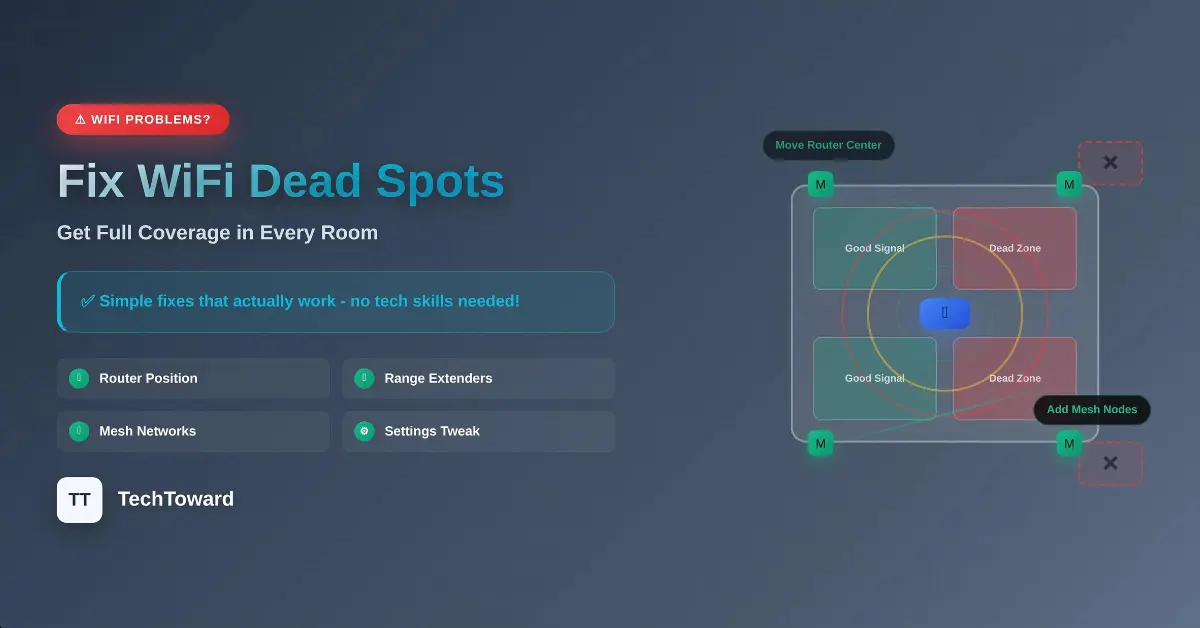Fixing WiFi dead spots in your home may seem frustrating, but with the right steps, you can enjoy smooth internet coverage in every room without complicated tech skills.
If you’ve ever been on a video call that froze mid-sentence, struggled to stream your favorite show in the bedroom, or noticed your smart devices dropping connection, you’re not alone. WiFi dead zones are one of the most common home networking issues, and the good news is—they can be fixed.
In this guide, we’ll break down why dead spots happen, how to find them, and the most effective ways to eliminate them—whether you’re a beginner or a tech-savvy homeowner.
What Are WiFi Dead Spots?
A WiFi dead spot (also called a dead zone) is an area in your home where your wireless signal either drops to very low speeds or disappears completely. This happens because WiFi signals, just like radio waves, weaken as they travel through walls, floors, and obstacles.
Common causes of dead spots include:
- Thick walls, concrete, or brick blocking signals.
- Distance from the router (signal weakens over long range).
- Interference from household appliances like microwaves or cordless phones.
- Router placement in a corner, cabinet, or behind furniture.
- Outdated router hardware that can’t keep up with modern needs.
👉 Imagine your WiFi router like a lamp. The closer you are, the brighter the light. But the further you move away—or if walls are in between—the darker it gets.
Why Fixing Dead Spots Matters
Some people tolerate poor WiFi by just “living with it,” but fixing dead zones comes with big benefits:
- Smooth streaming & gaming: No more buffering or lag.
- Productivity boost: Better video calls and faster downloads.
- Smart home reliability: Devices like cameras, thermostats, and voice assistants need consistent WiFi.
- Resale value: A well-connected home is a modern selling point.
How To Find WiFi Dead Spots in Your Home
Before fixing the problem, you need to locate it. Here’s how:
1. Walk-Test with Your Device
Take your phone or laptop and move around your house while watching the WiFi signal bars. Note where they drop.
2. Use a WiFi Analyzer App
Free apps like WiFi Analyzer (Android) or NetSpot (Mac/Windows) create a map of your signal strength.
3. Check Connected Devices
If smart bulbs, TVs, or cameras keep disconnecting in specific rooms, that’s a sign of a dead spot.
Step-By-Step: How To Fix WiFi Dead Spots
Now let’s go through practical solutions—from simple to advanced.
1. Reposition Your Router (First & Easiest Fix)
- Place your router in a central location instead of a corner.
- Elevate it on a shelf, away from the floor.
- Keep it out in the open, not hidden in a cabinet.
- Avoid placing it near microwaves or large electronics.
🔑 Pro tip: If your home is multi-story, place the router on the middle floor.
2. Upgrade Your Router
If your router is more than 4–5 years old, it may not support modern WiFi standards like WiFi 6, which deliver better range and stability.
Look for:
- Dual-band or tri-band routers (2.4 GHz for range, 5 GHz/6 GHz for speed).
- Beamforming technology that directs signals to devices.
- Strong antennas for better coverage.
3. Add a WiFi Range Extender
A range extender repeats your router’s signal into weak areas. It’s budget-friendly but works best when placed halfway between your router and the dead spot.
👍 Best for small homes or fixing one stubborn dead zone.
👎 Can reduce speed since it repeats signals.
4. Use a Mesh WiFi System
A mesh network uses multiple nodes (small routers) spread around your house. Unlike extenders, they create one seamless network.
- Perfect for large homes or houses with thick walls.
- Devices automatically connect to the nearest node.
- Brands like Google Nest WiFi, Eero, and Netgear Orbi are popular.
💡 Real-life example: A family living in a three-story townhouse solved poor basement WiFi by installing a mesh system—now every floor has strong coverage.
5. Upgrade to Powerline Adapters
If WiFi struggles through walls, powerline adapters use your home’s electrical wiring to carry internet signals. Just plug one near the router and another in the dead zone room.
- Great for gaming consoles or TVs that need a stable connection.
- Less setup than running Ethernet cables.
6. Run Ethernet Cables (The Ultimate Fix)
For the best performance, run an Ethernet cable to the dead zone and connect a second WiFi access point.
- Provides the fastest, most reliable fix.
- Ideal if you’re remodeling and can hide cables inside walls.
7. Optimize WiFi Settings
- Change your WiFi channel to avoid interference from neighbors.
- Use 5 GHz band for faster speeds nearby, 2.4 GHz band for long range.
- Enable Quality of Service (QoS) settings to prioritize video calls or gaming.
Advanced Tips for Tech-Savvy Users
- Install external antennas on routers that support them.
- Use VLANs to separate work, gaming, and smart home traffic.
- Regularly update firmware for security and performance.
- Disable unused features like WPS for safety and efficiency.
Common Mistakes to Avoid
- Placing the router on the floor or in a closet.
- Using too many range extenders (can cause interference).
- Ignoring interference from smart devices.
- Not updating your internet plan—sometimes the issue is speed, not coverage.
FAQs About Fixing WiFi Dead Spots
1. What’s the cheapest way to fix a WiFi dead spot?
Repositioning your router or using a WiFi range extender is the most affordable quick fix.
2. Is a mesh WiFi system better than an extender?
Yes, mesh systems provide seamless coverage, while extenders may slow speeds. For large homes, mesh is the better investment.
3. Can furniture block WiFi signals?
Yes. Large furniture like bookshelves or metal cabinets can weaken signals, especially if your router is hidden behind them.
4. Why does my WiFi work in some rooms but not others?
Distance, walls, and interference are the main culprits. Rooms farther away or with thick barriers are more likely to be dead zones.
5. Do smart TVs and consoles need Ethernet?
Not always, but Ethernet gives the most reliable connection for streaming and gaming.
Final Thoughts
Fixing WiFi dead spots in your home doesn’t have to be complicated. Start with simple steps like moving your router, then consider upgrades like mesh WiFi or Ethernet for stubborn areas. With the right solution, you’ll enjoy fast, reliable coverage in every room.
👉 If you’re ready to say goodbye to buffering and dropped calls, start by checking your router placement today—or upgrade to a modern WiFi system for a long-term fix.


